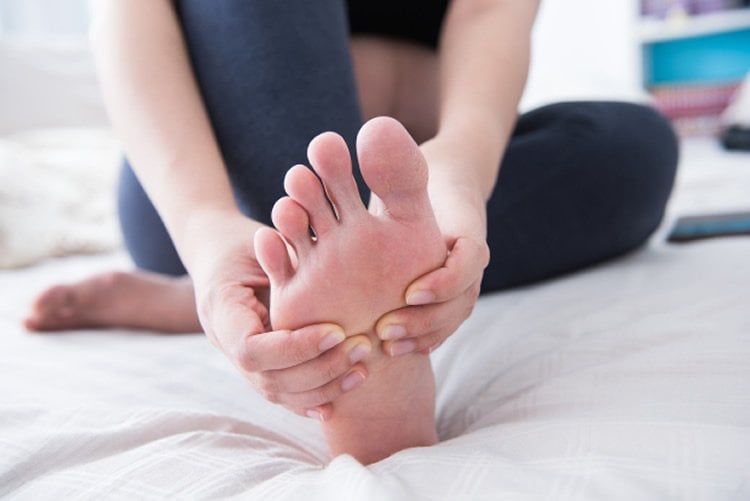Summary: A new study reports that relaxing flexed muscles in your foot can reduce the ability of your hands to respond to stimulation.
Source: Frontiers.
By relaxing flexed muscles in your foot, you can reduce the ability of your hands to respond to stimulation known as excitability, a study published in the open-access journal Frontiers in Human Neuroscience found.
Although this result might sound bizarre, movement in one limb interfering with movement in another is something you have probably discovered yourself. Anyone who has ever tried to rub their head while patting their belly can confirm this – failing at that wasn’t your fault either, although it was pretty humorous.
The muscles in your body contract to pull on your bones and relax to release them again, in response to neural impulses. This forms the basis of movement. However, coordinating both muscle contraction and relaxation is essential for normal physical activity.
Rapidly switching between these states is particularly important in activities where complex movements are required, like sports or playing musical instruments.
While the balance between muscle relaxation and contraction is important, they are distinct processes in their own right. Brain imaging studies show that specific areas of the brain activate during muscle relaxation, indicating that it is an independent and active neurological process, and not merely the end or absence of muscle contraction.
Researchers have known for a while that the relaxation of a muscle in one limb can affect the action of muscles in other limbs. However, they have not yet fully identified the neural mechanisms responsible for this.
The researchers behind this study are interested in determining if and how muscle relaxation in remote muscles, such as those of the foot, can affect the function of muscles in the hand. The team, based in Japan, used a technique called transcranial magnetic stimulation, in healthy volunteers.
The technique involves placing a probe near the head, which can generate a magnetic field and produce a small electric current in specific areas of the brain. This allowed the researchers to examine the brain circuitry involved in foot relaxation and hand movement. In order to assess muscle excitability, the team used sensors to measure the electrical activity in forearm muscles, which control movement of the hand.
Volunteers relaxed the muscles in their clenched right foot, while the researchers stimulated the area of the brain responsible for activation of muscles in the forearm, and simultaneously measured the effect on muscle excitability in the right forearm.

Strangely, muscle excitability in the forearm decreased immediately following relaxation of the foot. The team performed additional experiments to find the underlying cause of this phenomenon and found that corticospinal excitability of the forearm muscles decreased following foot relaxation.
The corticospinal tract consists of neurons involved in controlling movement and runs from the brain cortex to the spinal cord. Neurons involved in activating the forearm muscles were not as excitable following relaxation of the foot. The team found some evidence that this happens because of an inhibitory effect within the brain cortex itself, caused by foot muscle relaxation.
However, the exact neural mechanism underlying this is still somewhat of a mystery, since there is no anatomical connection between the areas controlling hands and feet in the region of the brain where the researchers observed the effects. Meanwhile, you still can’t rub your head while patting your belly, but don’t feel bad – there’s some complicated stuff going on in there.
Source: Conn Hastings – Frontiers
Image Source: NeuroscienceNews.com image is adapted from the Frontiers press release.
Original Research: Full open access research for “Muscle Relaxation of the Foot Reduces Corticospinal Excitability of Hand Muscles and Enhances Intracortical Inhibition” by Kouki Kato, Tetsuro Muraoka, Nobuaki Mizuguchi, Kento Nakagawa, Hiroki Nakata and Kazuyuki Kanosue in Frontiers in Human Neuroscience. Published online May 10 2016 doi:10.3389/fnhum.2016.00218
[cbtabs][cbtab title=”MLA”]Frontiers “Relaxing Your Feet Affects Your Hands.” NeuroscienceNews. NeuroscienceNews, 6 September 2016.
<https://neurosciencenews.com/hand-feet-relaxation-4978/>.[/cbtab][cbtab title=”APA”]Frontiers (2016, September 6). Relaxing Your Feet Affects Your Hands. NeuroscienceNew. Retrieved September 6, 2016 from https://neurosciencenews.com/hand-feet-relaxation-4978/[/cbtab][cbtab title=”Chicago”]Frontiers “Relaxing Your Feet Affects Your Hands.” https://neurosciencenews.com/hand-feet-relaxation-4978/ (accessed September 6, 2016).[/cbtab][/cbtabs]
Abstract
Muscle Relaxation of the Foot Reduces Corticospinal Excitability of Hand Muscles and Enhances Intracortical Inhibition
The object of this study was to clarify the effects of foot muscle relaxation on activity in the primary motor cortex (M1) of the hand area. Subjects were asked to volitionally relax the right foot from sustained contraction of either the dorsiflexor (tibialis anterior; TA relaxation) or plantarflexor (soleus; SOL relaxation) in response to an auditory stimulus. Single- and paired-pulse transcranial magnetic stimulation (TMS) was delivered to the hand area of the left M1 at different time intervals before and after the onset of TA or SOL relaxation. Motor evoked potentials (MEPs) were recorded from the right extensor carpi radialis (ECR) and flexor carpi radialis (FCR). MEP amplitudes of ECR and FCR caused by single-pulse TMS temporarily decreased after TA and SOL relaxation onset, respectively, as compared with those of the resting control. Furthermore, short-interval intracortical inhibition (SICI) of ECR evaluated with paired-pulse TMS temporarily increased after TA relaxation onset. Our findings indicate that muscle relaxation of the dorsiflexor reduced corticospinal excitability of the ipsilateral hand muscles. This is most likely caused by an increase in intracortical inhibition.
“Muscle Relaxation of the Foot Reduces Corticospinal Excitability of Hand Muscles and Enhances Intracortical Inhibition” by Kouki Kato, Tetsuro Muraoka, Nobuaki Mizuguchi, Kento Nakagawa, Hiroki Nakata and Kazuyuki Kanosue in Frontiers in Human Neuroscience. Published online May 10 2016 doi:10.3389/fnhum.2016.00218






